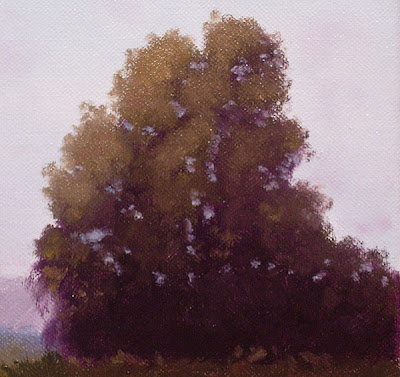 Now, on this tree I am going to have the upper half of the tree catching more light and the lower section in shadows. I like the darks here but I want the bottom really dark so I'm going to add a little more of my dark mix down there to darken that part more. That gets me to this point...
Now, on this tree I am going to have the upper half of the tree catching more light and the lower section in shadows. I like the darks here but I want the bottom really dark so I'm going to add a little more of my dark mix down there to darken that part more. That gets me to this point...
 That look pretty good so lets get started adding the mids....
That look pretty good so lets get started adding the mids....
Step 2 Adding the Mid Values...
...or Middle values which are a lower value green mix. In other words trees are like dark green, green and yellow but we adjust all that depending on the tree. Since there are all of these color variations with trees I just call them darks, mids and highlights. My mid green is going to be the same color combination as the darks mix but with less Alizarin and more Cad Yellow Pale. Here is what it looks like as we begin...
 I began by painting thicker mids at the top of the tree and thinner towards the bottom with a light touch of the brush. Most of the mids will be covered by highlights but you can choose to leave as much of your mids showing as you like. The mids here will show as a slight ring around my highlights.
I began by painting thicker mids at the top of the tree and thinner towards the bottom with a light touch of the brush. Most of the mids will be covered by highlights but you can choose to leave as much of your mids showing as you like. The mids here will show as a slight ring around my highlights.
Step 3..Adding Highlights...
Here you can see how I have blended the highlight mix to the sunlit area. This mix is the same as before but with more Cad Yellow Pale. I faded my highlights from top to bottom and left to right. My light sorce is from the left so I'm leaving the darker colors to suggest shade on the right side of the tree.  Step 4 Skyholes and Trunks...
Step 4 Skyholes and Trunks...
After the foliage is done we need to add some light peeking through the trees and to hep us shape our tree better. I use just a slightly darker shade of my sky mix to add skyholes. For turnks and branches I've just added light strokes with white and a bit of my dark mix added.
 and now the trunks and branches...
and now the trunks and branches...
The only thing I do after this step is to go around and tweak the tree up...a dab of color altered here and there, some edge work etc...just little things to make it look good.
I think that's a pretty convincing Eucalyptus tree...not the pom pom type of Euc, more the bush looking one that my neighbor has. I have both on my property. So, these are not as hard as you might have thought. Remember, darks, mids, highlights, skyholes and trunks...that's it. Below is how the tree looks in the competed painting....Hope you got something out of this and give it a try.
 "Prelude To Evening"
"Prelude To Evening"
9"x12"



 The view to the top of the peninsula Mustard abounds....
The view to the top of the peninsula Mustard abounds.... Me, working it up on the 9"x12" panel. This was a great spot. The field in from of me used to be a bean field way back in the 40's.
Me, working it up on the 9"x12" panel. This was a great spot. The field in from of me used to be a bean field way back in the 40's. Walk to the edge of the bean field and this would be your view down onto the Pacific Ocean. Is this place awesome or what!
Walk to the edge of the bean field and this would be your view down onto the Pacific Ocean. Is this place awesome or what!

 the finished painting.....needs a brush for that mustard!
the finished painting.....needs a brush for that mustard!
 Poppies with a yellowish tint
Poppies with a yellowish tint 

